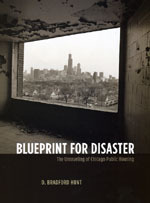October 28, 2009 Categories: Reviews
Blueprint for Disaster: The Unraveling of Chicago Public Housing
2009. University of Chicago Press. 380 pp. $35.
Founded in the 1930s as an antidote to slumlords, by the 1970s the Chicago Housing Authority had itself become one. D. Bradford Hunt’s new book tells the story as crisply and coolly as possible, demonstrating along the way that this turnabout was more a tragedy than the result of premeditated evil. Evil was present, but most actors wanted to do the right thing, and strove to do so even in difficult circumstances when they couldn’t foresee or forestall the result. Mayor Richard J. Daley — far from blameless in other respects — saw that high-rises full of poor people were a disaster in the making and lobbied for slightly more generous funding to make low-rises possible. {137-8}

Causal factors in this complex public-policy chain reaction include New Deal timidity, conservative intransigence, modernist architectural arrogance, white racism, reformers’ fixation on slum clearance, governmental cost-cutting and failure to adapt, union greed, administrative incompetence, administrative corruption, and a general failure of leadership except (as conditions deteriorated) among the public-housing tenants themselves.
As this list suggests, Hunt is ruthlessly nonpartisan in his assessments; for those tired of books with predictable heroes and villains, this one is a tonic. Like an expert surgeon, he peels away the layers to show how the progressive desire to house the poorest first and foremost actually contributed to the outcome: poor people isolated and confined in high-rise slums where gangs made the rules.
Hunt also highlights one important causal factor that has escaped even most hindsight. As built, the high-rises had an unprecedentedly high ratio of kids to grownups. That combined with their design flaws would likely have doomed even good management. Note that Hunt is not blaming the victims: “CHA projects designed between 1951 and 1959 were entirely new demographic worlds. No one had ever constructed a community with two youths for every adult in a vertical space, and on one . . . had the social resources to confront the problems caused by overwhelming populations of youiths. . . . the planning choices of the CHA raised the bar for achieving collective efficacy to daunting heights and made residents’ efforts to control the chaos of the projects incredibly arduous.” {179}
This is primarily a policy history, but it bears on architectural practice as well, since the conventional wisdom lays much blame on Le Corbusier’s dubious vision of urbanism. From an architectural point of view, however, this book’s takeaway lesson is not so much that modernist design was bad news — although it often was — but that modernist arrogance was a potent ingredient in the fatal stew.
Hunt analyzes the January 1952 issue of Architectural Forum with devastating effect. In an eighteen-page discussion of high-rise design in public housing, the CHA’s Elizabeth Wood acknowledged error and explained in detail how and why her previous endorsement of high-rise public housing had been mistaken. (Note that this was years before the Robert Taylor Homes and other monoliths were built; there was still time to steer away.) But her voice was overwhelmed and marginalized by the magazine’s editor, Douglas Haskell. Hunt writes, “Whereas Wood began with gendered observations of family living patterns and the desires of tenants, Haskell presented the architect as master of spatial realities to which tenants must conform. Working from the premise that ‘increased density of population and building’ was an urban fact, Haskell declared the preference of tenants was ‘unimportant’ and that ‘a public not used to elevators or play corridors must learn to use them, just as new car owners must be taught to drive.’” {133}
Haskell had no monopoly on arrogance. Wood was much the best administrator the CHA ever had (eventually losing her job in part for refusing to bow to the white racism of Chicago’s City Council and mayor). {103} But it was on her watch, in 1946, that the agency strategically cropped inconvenient photographs and made unwarranted and questionable assumptions, all in order to portray bulldoze-and-build projects as cheaper than rehabilitation. {73-4} Hunt shows great ability to locate and analyze obscure documents, but even he can’t discern whether these falsifications were conscious or simply a yielding to the zeitgeist, the vague but near-universal feeling that rehab was just somehow wrong — a compromise and declension from building anew from a clean slate — and so couldn’t possibly be more economical.
Modernist design dogma has since been vanquished, but the dragon of arrogance remains at large in the land, now deployed on behalf of new dogmas. Hunt maintains a cool distance from the current CHA’s Plan for Transformation, which is replacing the high-rises with “mixed-income” New Urbanist look-alike buildings — at densities too low either to support transit or to allow those evicted from the high-rises to return.
“Once again,” he concludes, “policymakers have begun to clear the slums and build better housing for the poor. . . . Whether this new vision has conquered the complex problem of housing the poor any better than the original vision of the 1930s remains to be seen.” {295}
#
